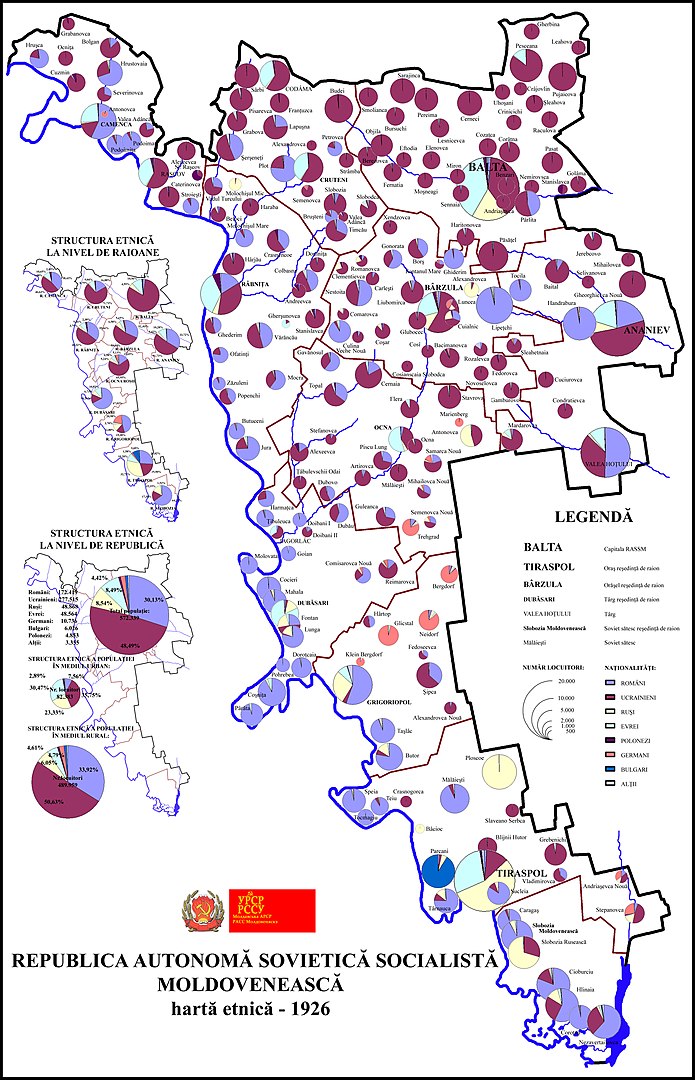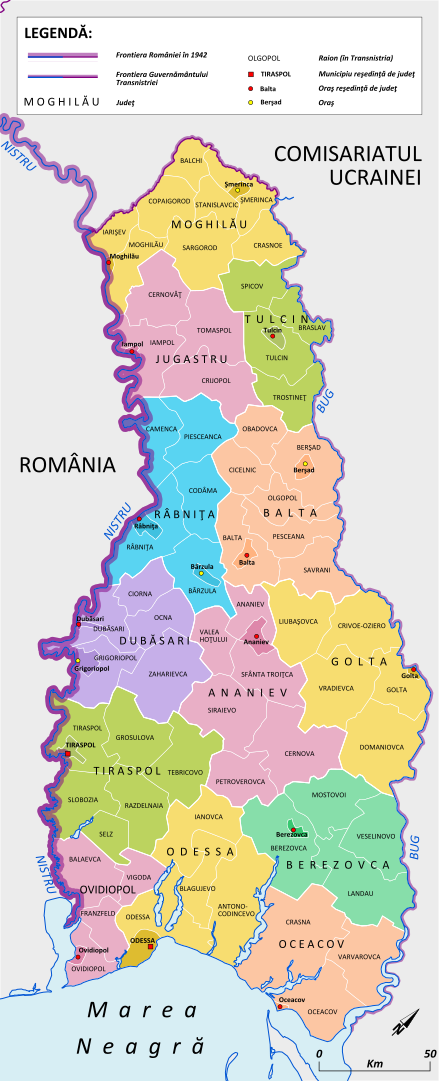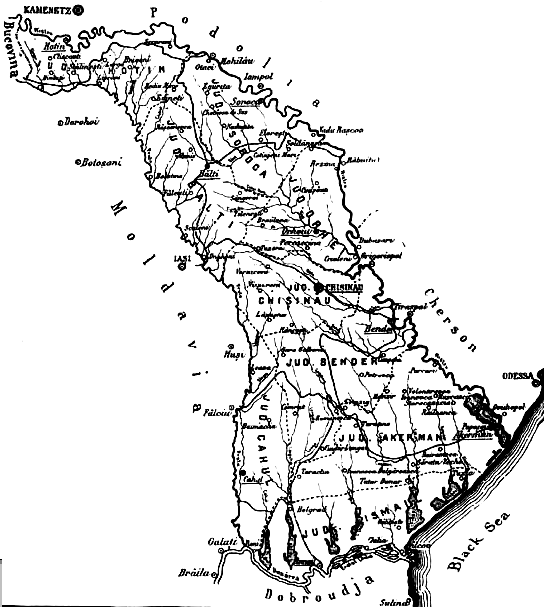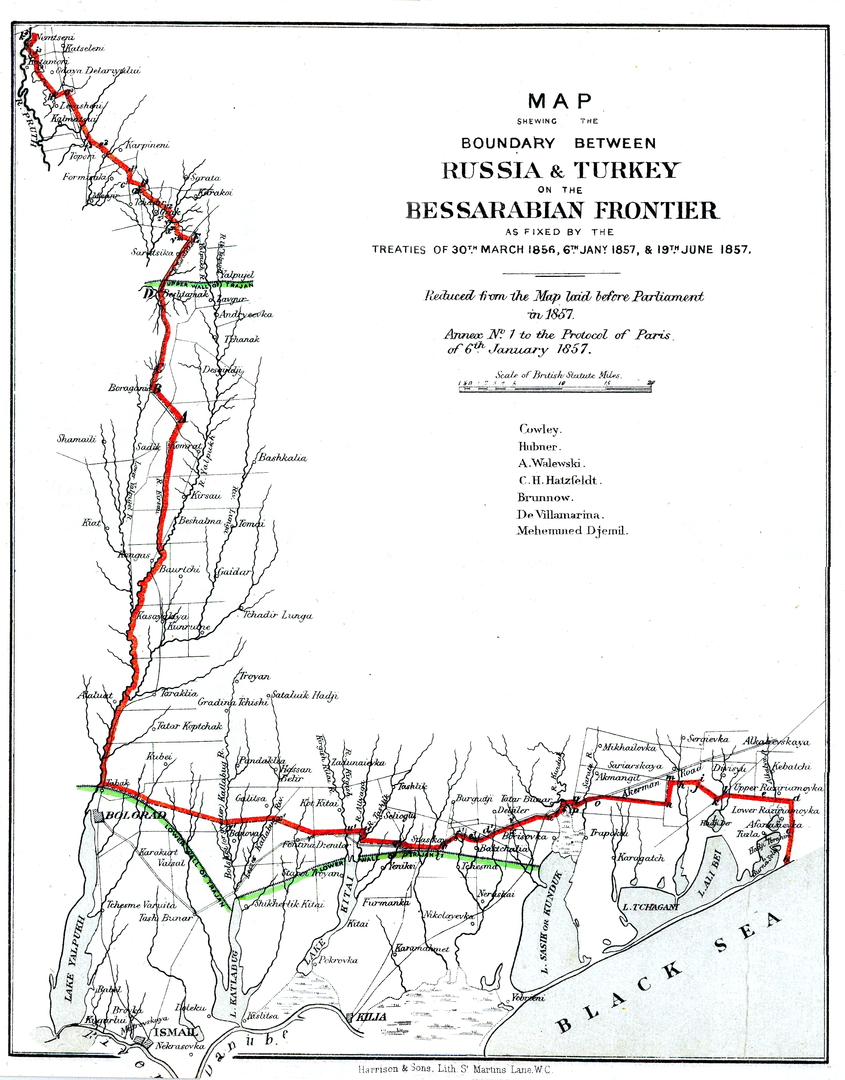How did Transnistria emerge, and what is its history?
Date: Thu Nov 14 2019 ; Tags:
Most people have never heard of Transnistria, and it is a curious corner of Europe that's outside normal legal structures. It claims to be a country, but the only other "countries" which recognize its existence are other breakaway regions that no other countries recognize as legitimate countries. Legally Transnistria is considered part of the Republic of Moldova, and its existence is the result of a "war" in 1991. Did Transnistria always exist as part of Moldova? No, that like many things about Transnistria is a fiction created by the old Soviet Union.
_(semi-secession).svg.png)
Transnistria is officially called the Pridnestrovian Moldavian Republic. It is a de-facto country, a.k.a. sovereign state, between the Dneister River and Ukraine. The name is clearly formed from words meaning "Across the Dneister". Today the territory is internationally recognized as being part of the Republic of Moldova. The government of Moldova recognizes the territory as the Transnistria autonomous territorial unit with special legal status (Romanian: Unitatea teritorială autonomă cu statut juridic special Transnistria), or or Stînga Nistrului ("Left Bank of the Dniester").
The area now known as Transnistria was never associated with Moldova or Wallachia or Romania at any time in history. The addition of this land to what's now known as the Republic of Moldova was the result of geopolitical scheming by the USSR in the 1920's.
The area beyond the Dneister River clearly has a history and ethnicity associated with Ukraine. The only reason it is associated with Moldova is due to the USSR's plans in 1924.
The formation of the modern state which calls itself Transnistria
This pseudo-country came into being in 1991. This was shortly after the breakup of the Soviet Union, and the formation of the Republic of Moldova from Moldova SSR. It is understood that Russia, the successor country to the Soviet Union, wanted to do something to prevent the territory between the Prut and Dneister rivers from rejoining Romania.
The government of Moldova SSR made several moves in 1889 which alarmed those of Russian or Slavic ethnicity inside Moldova SSR. These included making Moldovan the official language of Moldova SSR, returning Moldovan to the latin alphabet, and declaring that Moldovan and Romanian have a shared linguistic identity. During the period of Soviet Union control, the Russification effort included insisting that Moldovans are a separate ethnic identity from Romanians, forcing the population to use the cyrillic alphabet, and using Russian as the primary language.
By 1991 the Moldova SSR became the Republic of Moldova, because all the SSR's became independent countries, and the dispute grew into an armed conflict. The population was largely ethnic Russian and ethnic Ukrainian, and military forces from both countries supported folks in that area.
Eventually the fighting devolved into a status of an enforced cease-fire, with units of the Russian army stationed in Transistria. Supposedly the Russians are there as a peace keeping force. But, the presence of Russian troops in Transnistria gives Russia a degree of leverage over political results in that region.
For example it would be extremely difficult for Romania and Moldova to reunite because doing so would require settling the status of those Russian troops, as well as the status of the Transnistrians who fought the Moldovan government.
Was Transistria always a part of Moldova? No
The Moldavian Autonomous Soviet Socialist Republic (Moldova ASSR) was the original precursor to what is now called Transnistria. It was carved out of Ukraine SSR in October 1924, and maintained as an autonomous republic of Ukraine SSR until August 1940.
In 1924 the Soviet Union was newly formed. The goal sought by forming Moldova ASSR was to radicalize pro-Soviet feelings in Bessarabia, and to create a "bridgehead" with which to extend the USSR towards the Balkans.
Immediately prior to the end of Moldova ASSR, on June 26, 1940, the USSR demanded that Romania immediately cede Bessarabia and Northern Bukovina to the USSR. Bessarabia is otherwise known as the land between the Prut and Dneister River's. When Romania acceeded to that demand, on June 28, Soviet troops crossed the Dniester and occupied Bessarabia, Northern Bukovina, and the Hertza region. These territories had significant populations of ethnic Ukrainians. Then on August 2, 1940 the USSR established the Moldavian Soviet Socialist Republic (Moldavian SSR), and in the process dissolved the Moldavian Autonomous Soviet Socialist Republic. Further, some of the lands were directly added to Ukraine SSR and remain a part of Ukraine in 2019 despite significant Romanian populations.
During World War II, Romania then joined with Germany because Germany promised assistance to regain Moldova from the USSR. But in 1994 when the USSR had defeated Germany's entry into the USSR, Romania switched sides turning on Germany and joined forces with the USSR.
After World War II, the USSR re-established Moldova SSR as a separate country from Romania, and kept the territory which had been the Moldavian Autonomous Soviet Socialist Republic attached to Moldova SSR.
In short the territory in question was, before 1924, part of Ukraine. The USSR then established that territory as having a pseudo-Moldovan identity, and after World War II artificially attached that territory to Moldova SSR.
A telling point is the data about ethnicity of the folks living in 1924 in the territory now known as Transnistria.
Ethnicitity of Moldova ASSR before 1924

| Ethnic group | 1926 Count | 1926 % | 1936 Count | 1936 % |
|---|---|---|---|---|
| Ukrainians | 277,515 | 48.5% | 265,193 | 45.5% |
| Moldavians | 172,419 | 30.1% | 184,046 | 31.6% |
| Russians | 48,868 | 8.5% | 56,592 | 9.7% |
| Jews | 48,564 | 8.5% | 45,620 | 7.8% |
| Germans | 10,739 | 1.9% | 12,711 | 2.2% |
| Bulgarians | 6,026 | 1.1% | ||
| Poles | 4,853 | 0.8% | ||
| Romani | 918 | 0.2% | ||
| Romanians | 137 | 0.0% | ||
| Other | 2,300 | 0.4% | 13,526 | 2.4% |
| Total | 572,339 | 582,138 |
The problem with this table is that Moldovan and Romanian are the same thing. It is a fiction created by the USSR that Moldovan's have a separate ethnicity from Romanians. However, the table lists Moldovans and Romanians as separate ethnicities.
In any case it tells us that before 1924 this territory was clearly part of Ukraine and that the majority of the population before and after the formation of Moldova ASSR was Ukrainians.
Transnistria during World War II

As said earlier, Moldavian Autonomous Soviet Socialist Republic (Moldovian ASSR), was disbanded in August 1940 when the Soviet Union added that territory to Moldova SSR.
That the USSR grabbed a bunch of territory from Romania, the Kingdom of Romania responded by joining forces with Germany. They quickly invaded the USSR and Romania regained the territories that had been ceded to the USSR. This of course included Bessarabia, and also included the land now known as Transnistria.
During the period Romania had regained these territories, the area now known as Transnistria was known as the Transnistria Governorate. This was the first time in history that Moldovan or Romanian governments ruled over this territory. Romania never formally annexed this area, but organized the territory as the Guvernământul Transnistriei under Romanian governor, Gheorghe Alexianu.
One thing to notice is that the Transnistria Governorate extended all the way to the Black Sea, including the area around Odessa. Further, the area of Bessarabia a.k.a. Moldova extended all the way to the Black Sea. In 2019, the area around Odessa all the way to the Prut River is part of Ukraine.
By 1994 the tide of World War II turned, and the German forces were in retreat. The USSR were on the borders and Romania switched sides turning on Germany and joining forces with the USSR. That action hastened the end of World War II.
After World War II, the USSR recreated Moldova SSR including the land now known as Transnistria.
Russification
During USSR's rule over Moldova SSR, a set of ideas was inserted into the population that we can only describe as Russification. That is, the overlaying of Russian society onto a country that was never Russian.
This started with the assertion that the Moldovan language is distinct from the Romanian language, and that the Moldavians in Bessarabia were "oppressed by Romanian imperialists". This is false since historically the Principality of Moldova included the land up to the Dneister River for hundreds of years. The only claim the USSR had to any of this territory is that in 1812 the Russian empire conquered the land between the Prut and Dneister rivers, and ruled that territory for awhile.
In Moldova SSR, the USSR forced the population to use the Cyrillic alphabet to spell Romanian. A linguist, Leonid Madan, was assigned the task of establishing a literary standard of a Moldovan language with lots of Russian loan words.
These ideas were heavily promoted in the area now known as Transnistria. Perhaps because that area had a stronger presence of Ukrainians the ideology of reshaping Transnistria and Moldova as Russian was attractive.
In 1989 the Moldova SSR, as noted above, undid those policies. But in Transnistria the policies are still in force.
Bessarabia

This word has been used several times in the above text, and it must be explained.
Bessarabia is a region historically identified as the land between the Prut and Dneister River's. Note that the map shows Bessarabia extending to the Black Sea, and it does not include the area around Odessa. At the north end of the map is an area called Bucovina, part of which in 2019 is in Ukraine and part in Romania. Bucovina is a completely separate sad story.
In the aftermath of the Russo-Turkish War (1806-1812), the eastern parts of the Principality of Moldova were ceded to the Russian Empire. At that time the Principality of Moldova was a vassal of the Ottoman Empire.
This area was organized as the Bessarabia Governorate, or in Russian the Bessarabia Oblast, and later called Guberniya of Bessarabia.
Before 1812 this area had no particular name. It was simply part of the land of the Principality of Moldova.
At first the Boyars of Bessarabia protested that the Ottoman's had no right to give the territory to the Russian Empire. Moldova was a vassal of the Ottoman Empire, and not an Ottoman province. But that didn't stop the Sultan from giving the territory to the Russians.
After the annexation, the Boyars petitioned for self-rule and a civil government based on traditional Moldovian laws. Initially the Russian Empire allowed there to be a degree of autonomy. But by 1821-25 the Russian Empire began reforms that ended the autonomous status of the area.
This led to an earlier phase of Russification than what was mentioned earlier. The Romanian language was banned in schools and Russian was the official language. The importation of books from Moldova and Wallachia was banned.
The Russification policy held back the Bessarabian population. They kept speaking Romanian despite Russian being the official language. That meant the population had no access to books written in their language (Romania) and no opportunity to learn to read and write their own language. The Russian Empire set up over 400 schools in rural parish's, but as the instruction was in Russian the students did not attend. By the 1880's only 23 of those schools remained.
Anyone who protested was exiled to Siberia.

In 1856 the Treaty of Paris caused the Russian Empire to cede the southern end of Bessarabia to the Principality of Moldova.
In 1895 Moldova and Wallachia joined together to form the first modern country named Romania.
In 1877, Romania and Russia signed a treaty alliance against the Ottoman Empire. In the treaty Russia promised to recognize Romania's independence and to respect its national borders. However after the Russo-Turkish war (1877-1878), the Russian Empire grabbed back that region. They claimed that in 1856 the territory was ceded to Moldova, and that since Moldova no longer existed (becoming part of Romania) that Russia had followed the letter of the guarantee.
Sources:
https://en.wikipedia.org/wiki/Transnistria
https://en.wikipedia.org/wiki/Moldova
https://en.wikipedia.org/wiki/Moldavian_Autonomous_Soviet_Socialist_Republic
https://en.wikipedia.org/wiki/Transnistria_Governorate
